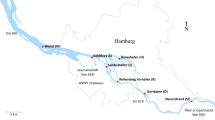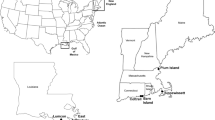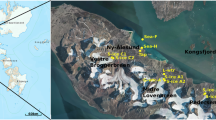Abstract
Anaerobic oxidation of ammonium (anammox) is recognized as an important process in the marine nitrogen cycle yet nothing is known about the distribution, diversity and activity of anammox bacteria in the terrestrial realm. In this study, we report on the detection of anammox sequences of Candidatus ‘Brocadia’, ‘Kuenenia’, ‘Scalindua’ and ‘Jettenia’ in marshes, lakeshores, a contaminated porous aquifer, permafrost soil, agricultural soil and in samples associated with nitrophilic or nitrogen-fixing plants. This suggests a higher diversity of anammox bacteria in terrestrial than in marine ecosystems and could be a consequence of the larger variety of suitable niches in soils. Anammox bacteria were not ubiquitously present but were only detected in certain soil types and at particular depths, thus reflecting specific ecological requirements. As opposed to marine water column habitats where Candidatus ‘Scalindua’ dominates anammox guilds, ‘Kuenenia’ and ‘Brocadia’ appear to be the most common representatives in terrestrial environments.
Similar content being viewed by others
Introduction
Anammox bacteria form a deep-branching, monophyletic group within the Planctomycetes and anaerobically oxidize ammonium to dinitrogen gas with nitrite as an electron acceptor (Kuenen, 2008). They are active at redox transition zones in various aquatic environments, particularly in oceanic oxygen-minimum zones (for example, Dalsgaard et al., 2003; Kuypers et al., 2003; Stevens and Ulloa, 2008) and in marine surface sediments (for example, Hietanen and Kuparinen, 2008; Rich et al., 2008), but also in sea ice (Rysgaard et al., 2008), and meromictic lakes (Schubert et al., 2006). However, nothing is known to date about the distribution, diversity and activity of anammox in the terrestrial realm.
As anammox depends on the concomitant presence of both oxidized and reduced inorganic nitrogen compounds under anoxic conditions, we hypothesize that oxic/anoxic interfaces in terrestrial ecosystems provide appropriate habitats for anammox bacteria. In ‘oxic’ soils, this may include: the rhizosphere where the oxygen concentration is reduced compared with distant soil because of respiration of plant roots and microorganisms; the bulk soil where anoxic pockets exist within soil macro-aggregates; and the soil–groundwater table interface including its fluctuation zone. In water-saturated soils, such conditions are met in the rhizosphere of marsh plants, in which oxygen is transferred through the aerenchyme into the otherwise anoxic submersed soil (Brune et al., 2000).
The goals of this study were (i) to test whether anammox bacteria occur in soils, to assess their environmental distribution, and (ii) to determine their diversity at selected sites. A two-step molecular screening approach was established, consisting of an initial PCR amplification of Planctomycetales 16S rRNA followed by a second PCR targeting the 16S rRNA gene of anammox bacteria. Subsequent sequence analysis of cloned PCR products was performed to determine their phylogenetic affiliation. We show that soils are potential habitats for anammox bacteria and harbour a greater genus-level diversity than in marine water column environments. These results represent a first step towards a global understanding of the anammox process and the biogeography of anammox bacteria.
Results and discussion
Among the 112 samples collected at nine different geographical locations in Switzerland and France, 82 yielded PCR (for methodology, see Supplementary information) products for Planctomycetales and 60 for anammox bacteria (Table 1). Anammox PCR products were detected in different wetlands, lake shores, a contaminated porous aquifer, permafrost soil, agricultural soil and in samples associated with nitrophilic or nitrogen-fixing plants (Supplementary Table S1). This implies that anammox bacteria are also present in terrestrial environments and are mostly associated with water and/or high nitrogen contents. Although anammox bacteria may be widespread, eight out of nine locations were anammox positive, they are not ubiquitously detected. Usually, not all samples from a given location or environment yielded anammox bacterial PCR products. As in stratified water columns or in sediments where anammox activity is restricted to particular layers (Dalsgaard et al., 2003, 2005), anammox sequences were detected at particular depths along a soil profile (Supplementary Figures S1 and S2). Moreover, rhizosphere samples of Urtica dioica and Alnus incana collected at different locations resulted in positive as well as negative anammox PCR results. This may suggest that the global environmental conditions (for example, soil water regime, nitrogen content), rather than the microscale environmental conditions promote the enrichment of anammox bacteria to a detectable level. Environments where no anammox bacterial PCR products were observed included water-saturated grassland in the Camargue, planted grassland in Boudry and rhizosphere soil of Epilobium fleischeri in the Morteratsch glacier forefield where the environmental conditions were not sufficiently maintained to provide a stable ecological niche.
Phylogenetic analysis revealed that 29% of the clone sequences were closely related to the known anammox bacterial genera Candidatus ‘Brocadia’, ‘Kuenenia’, ‘Scalindua’ and ‘Jettenia’ (Figure 1). The remaining environmental clone sequences were related to Planctomycetes 16S rDNA sequences branching outside the ‘anammox bacterial cluster’ (Supplementary Figure S3). This cluster was defined on the basis of a limited number of available sequences from described anammox enrichment cultures, which were obtained from a narrow range of environments (for example, Schmid et al., 2003; Kartal et al., 2007b, 2008). Furthermore, the ‘external’ sequences have no close representatives among cultivated organisms. It is thus not possible to exclude that at least part of them belong to so far uncultivated anammox bacteria, which could well exist in soils with their inherent heterogeneity and diversity of niches. If they are not, it means that the primer sets used in this study, which were primarily developed as FISH probes (Schmid et al., 2005) are not narrowly specific for anammox bacteria. Increasing the number of certified anammox 16S rDNA sequences from enrichment cultures from a variety of soils or metagenomic studies could ultimately lead to a wider definition of the ‘anammox bacteria cluster’, and aid developing better-adapted primers. In this study, we considered only clones branching within the present ‘anammox bacteria cluster’ as representative of anammox bacteria.
Neighbour-joining tree showing the relationship between known anammox bacterial and closely related 16S rRNA gene sequences retrieved from the different terrestrial environments. Clone names are composed as follows: Sample name, followed by soil fraction according to Table 1. The number of times a sequence was detected among all tested clones of a sample is indicated in parentheses. For the WaA samples clone names are complemented with abbreviations for the reverse primers used for the sequential PCR (A: Amx820r, B: BS820r). Bootstrap values (1000 replicates) higher than 50% are shown and the scale bar represents 2% of sequence divergence.
A neighbour-joining phylogenetic tree was constructed with environmental and 16S rRNA gene sequences of the described anammox bacterial genera (Figure 1). Four of the five candidate genera were represented in our samples; (1) clone sequences from rhizosphere soil from Fraxinus excelsior (shore of Lake Loclat), Alnus viridis (Cadagno) and Alnus incana (shore of Lake Neuchâtel) were related to Ca. Kuenenia with more than 99% of similarity; (2) sequences from the ammonium-contaminated porous aquifer and Cladium mariscus rhizosphere from ‘La Grande Cariçaie’ clustered with Ca. Brocadia with more than 96% of similarity; (3) sequences from marsh sediment from the Camargue were associated with Ca. Scalindua with 94% similarity; and finally (4) sequences from permafrost from the Creux-du-Van were affiliated to Ca. Jettenia with 97% similarity. Two groups of clones could not be affiliated unambiguously to any described anammox genera yet formed distinct clusters within the anammox group (Figure 1). Cluster I uniquely consisted of sequences obtained from a salt marsh in southern France (Figure 1, CaMs4-SBS), whereas Cluster II contained sequences from a reductisol (Figure 1, LIR-OBS) and an ammonium-contaminated aquifer (AJ871743; Smits et al., 2009). Sequences from both clusters shared equal similarities of ∼95% with both Ca. Kuenenia and Ca. Brocadia and could represent so far undescribed anammox bacterial genera. Brocadia and Kuenenia species are traditionally found in wastewater treatment plants and bioreactors (Schmid et al., 2005). It has thus been suggested that the presence of these two genera in estuarine sediments might be because of urbanization (Dale et al., 2009). We show here that particularly Ca. Brocadia and Kuenenia are frequently detected in soils unaffected by any human activity.
In most cases, only one anammox taxon was detected in a sample; but as only a limited number of clones have been tested per environment this result must be interpreted cautiously. The only exceptions among the sampled locations were the Camargue marsh sediments, which harboured both Ca. Scalindua-related representatives and members of Cluster I. The finding of Ca. Scalindua in this saline ecotone that links the marine and the terrestrial realm is consistent with the previous observation that Ca. Scalindua predominates the marine anammox guild (for example, Penton et al., 2006; Schmid et al., 2007; Woebken et al., 2008). Similarly, studies on the biogeography of anammox bacteria in river estuaries revealed that Ca. Scalindua was the most abundant anammox genus at higher salt contents whereas Ca. Brocadia and Kuenenia were negatively correlated with salinity (Amano et al., 2007; Zhang et al., 2007; Dale et al., 2009). These findings might be interpreted as a continental signal of anammox bacteria in an environment typically dominated by Ca. Scalindua.
In this study, we provide evidence for the presence of anammox bacteria in a wide range of soil environments. The higher number of detected anammox bacterial genera in terrestrial as compared with the relatively homogenous marine water column environments may reflect the larger variety of offered anammox niches in soils. Anammox bacteria were not detected everywhere, showing that they require ecological minimum conditions such as oxic/anoxic interfaces and inorganic nitrogen compounds. Yet, the environmental conditions that control anammox activity in soil and determine, which anammox phylotypes thrive in an ecosystem are unknown. Whether soil anammox bacteria indeed perform the classical anammox process remains also to be shown. Recent physiological studies suggest that their metabolism is more versatile than presumed. They may grow heterotrophically and perform dissimilatory nitrate reduction to ammonium (Guven et al., 2005; Kartal et al., 2007a, 2008). Genome analysis of Kuenenia stuttgartiensis further suggested the possibility for anaerobic respiration of iron and manganese oxides (Strous et al., 2006). Future studies will therefore focus on the abundance and activity of anammox bacteria in soils to better understand their quantitative contribution to the terrestrial nitrogen cycle.
References
Amano T, Yoshinaga I, Okada K, Yamagishi T, Ueda S, Obuchi A et al. (2007). Detection of anammox activity and diversity of anammox bacteria-related 16S rRNA genes in coastal marine sediment in Japan. Microbes Environ 22: 232–242.
Brune A, Frenzel P, Cypionka H . (2000). Life at the oxic-anoxic interface: microbial activities and adaptations. FEMS Microbiol Rev 24: 691–710.
Dale OR, Tobias CR, Song B . (2009). Biogeographical distribution of diverse anaerobic ammonium oxidizing (anammox) bacteria in Cape Fear River Estuary. Environ Microbiol 11: 1194–1207.
Dalsgaard T, Canfield DE, Petersen J, Thamdrup B, Acuna-Gonzalez J . (2003). N2 production by the anammox reaction in the anoxic water column of Golfo Dulce, Costa Rica. Nature 422: 606–608.
Dalsgaard T, Thamdrup B, Canfield DE . (2005). Anaerobic ammonium oxidation (anammox) in the marine environment. Res Microbiol 156: 457–464.
Guven D, Dapena A, Kartal B, Schmid MC, Maas B, van de Pas-Schoonen K et al. (2005). Propionate oxidation by and methanol inhibition of anaerobic ammonium-oxidizing bacteria. Appl Environ Microbiol 71: 1066–1071.
Hietanen S, Kuparinen J . (2008). Seasonal and short-term variation in denitrification and anammox at a coastal station on the Gulf of Finland, Baltic Sea. Hydrobiologia 596: 67–77.
Kartal B, Kuypers MMM, Lavik G, Schalk J, Op den Camp HJM, Jetten MSM et al. (2007a). Anammox bacteria disguised as denitrifiers: nitrate reduction to dinitrogen gas via nitrite and ammonium. Environ Microbiol 9: 635–642.
Kartal B, Rattray J, van Niftrik LA, van de Vossenberg J, Schmid MC, Webb RI et al. (2007b). Candidatus ‘Anammoxoglobus propionicus’ a new propionate oxidizing species of anaerobic ammonium oxidizing bacteria. Syst Appl Microbiol 30: 39–49.
Kartal B, van Niftrik L, Rattray J, de Vossenberg J, Schmid MC, Damste JSS et al. (2008). Candidatus ‘Brocadia fulgida’: an autofluorescent anaerobic ammonium oxidizing bacterium. FEMS Microbiol Ecol 63: 46–55.
Kuenen JG . (2008). Anammox bacteria: from discovery to application. Nat Rev Microbiol 6: 320–326.
Kuypers MMM, Sliekers AO, Lavik G, Schmid MC, Jørgensen BB, Kuenen JG et al. (2003). Anaerobic ammonium oxidation by anammox bacteria in the Black Sea. Nature 422: 608–611.
Penton CR, Devol AH, Tiedje JM . (2006). Molecular evidence for the broad distribution of anaerobic ammonium-oxidizing bacteria in freshwater and marine sediments. Appl Environ Microbiol 72: 6829–6832.
Rich JJ, Dale OR, Song B, Ward BB . (2008). Anaerobic ammonium oxidation (Anammox) in Chesapeake Bay sediments. Microb Ecol 55: 311–320.
Rysgaard S, Glud RN, Sejr MK, Blicher ME, Stahl HJ . (2008). Denitrification activity and oxygen dynamics in Arctic sea ice. Polar Biol 31: 527–537.
Schmid MC, Maas B, Dapena A, van de Pas-Schoonen K, van de Vossenberg J, Kartal B et al. (2005). Biomarkers for in situ detection of anaerobic ammonium-oxidizing (anammox) bacteria. Appl Environ Microbiol 71: 1677–1684.
Schmid MC, Risgaard-Petersen N, van de Vossenberg J, Kuypers MMM, Lavik G, Petersen J et al. (2007). Anaerobic ammonium-oxidizing bacteria in marine environments: widespread occurrence but low diversity. Environ Microbiol 9: 1476–1484.
Schmid MC, Walsh K, Webb R, Rijpstra WIC, van de Pas-Schoonen K, Verbruggen MJ et al. (2003). Candidatus ‘Scalindua brodae’, sp. nov., Candidatus ‘Scalindua wagneri’, sp. nov., two new species of anaerobic ammonium oxidizing bacteria. Syst Appl Microbiol 26: 529–538.
Schubert CJ, Durisch-Kaiser E, Wehrli B, Thamdrup B, Lam P, Kuypers MMM . (2006). Anaerobic ammonium oxidation in a tropical freshwater system (Lake Tanganyika). Environ Microbiol 8: 1857–1863.
Smits THM, Hütttmann A, Lerner DN, Holliger C . (2009). Detection and quantification of bacteria involved in aerobic and anaerobic ammonium oxidation in an ammonium-contaminated aquifer. Biorem J 13: 41–51.
Stevens H, Ulloa O . (2008). Bacterial diversity in the oxygen minimum zone of the eastern tropical South Pacific. Environ Microbiol 10: 1244–1259.
Strous M, Pelletier E, Mangenot S, Rattei T, Lehner A, Taylor MW et al. (2006). Deciphering the evolution and metabolism of an anammox bacterium from a community genome. Nature 440: 790–794.
Woebken D, Lam P, Kuypers MMM, Naqvi SWA, Kartal B, Strous M et al. (2008). A microdiversity study of anammox bacteria reveals a novel Candidatus Scalindua phylotype in marine oxygen minimum zones. Environ Microbiol 10: 3106–3119.
Zhang Y, Ruan XH, Op den Camp HJM, Smits TJM, Jetten MSM, Schmid MC . (2007). Diversity and abundance of aerobic and anaerobic ammonium-oxidizing bacteria in freshwater sediments of the Xinyi River (China). Environ Microbiol 9: 2375–2382.
Acknowledgements
We thank Nicole Jeanneret for valuable technical assistance, Dr Markus Schmid (University of Vienna, Austria) for helpful discussions and providing anammox DNA, and ‘La Tour du Valat, Fondation Sansouire’ for providing access to the sampling sites in the Camargue. The Swiss State Secretariat for Science and Education-COST Action 856 (Project SER No. C04.0269) and the NCCR Plant Survival are acknowledged for financial support.
Author information
Authors and Affiliations
Corresponding author
Additional information
Supplementary Information accompanies the paper on The ISME Journal website (http://www.nature.com/ismej)
Supplementary information
Rights and permissions
About this article
Cite this article
Humbert, S., Tarnawski, S., Fromin, N. et al. Molecular detection of anammox bacteria in terrestrial ecosystems: distribution and diversity. ISME J 4, 450–454 (2010). https://doi.org/10.1038/ismej.2009.125
Received:
Revised:
Accepted:
Published:
Issue Date:
DOI: https://doi.org/10.1038/ismej.2009.125
Keywords
This article is cited by
-
Interactions Between Bacteria and Several Redox-Sensitive Metals (Fe, Mn, U) in the Sediments of the Yellow River Estuary Wetland, China
Estuaries and Coasts (2024)
-
Effects of pharmaceuticals on the nitrogen cycle in water and soil: a review
Environmental Monitoring and Assessment (2022)
-
Maintenance power requirements of anammox bacteria “Candidatus Brocadia sinica” and “Candidatus Scalindua sp.”
The ISME Journal (2021)
-
Glycogen metabolism of the anammox bacterium “Candidatus Brocadia sinica”
The ISME Journal (2021)
-
Diversity, abundance, and distribution of anammox bacteria in shipping channel sediment of Hong Kong by analysis of DNA and RNA
Ecotoxicology (2021)




